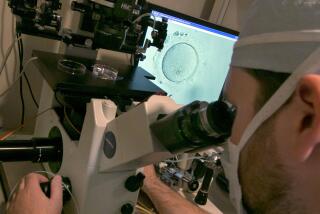Experts Lament Lax Screening of Artificial-Insemination Donors
- Share via
Men whose sperm is to be used in artificial insemination should be screened as rigorously as blood donors because of increasingly recognized risks of a variety of sexually transmitted diseases, from hepatitis to AIDS, two prominent experts contend.
And in urging greater adherence to standards already available for semen donor programs, the two doctors add that, with the contemporary complexities of diseases that can be sexually spread, “some things in life are not as straightforward as they used to be.”
That lament and the urgent call for more stringent surveillance of semen donors appeared last week in the Journal of the American Medical Assn.
Hepatitis Traced to Semen
One of the two experts is Dr. Laurene Mascola, a specialist in disease patterns with the Los Angeles County Department of Health Services.
The editorial message by Mascola and Dr. Mary Guinan, of the federal Centers for Disease Control in Atlanta, accompanied an account by Denver physicians of a case of a woman with hepatitis B--the form of the disease transmitted by a virus--traced to donor semen. The case report added documentation to earlier accounts linking hepatitis to artificial insemination.
The medical journal exchange, moreover, underscored several developments central to a larger dispute over the safety of artificial insemination. It has been linked to the spread of acquired immune deficiency syndrome, gonorrhea, herpes, syphilis, vaginitis, a type of pneumonia, chlamydia and a variety of other infections as well as hepatitis.
These discoveries have provoked a controversy that has raged in reproductive medicine for at least four years, with two major professional organizations issuing standards and guidelines that conflict--at least in part. At the center are these questions:
- Should the use of frozen semen replace fresh, since frozen permits comprehensive testing before attempts to fertilize a woman and fresh is far less testable?
- On the other hand, though, is frozen semen less reliable than fresh in its effectiveness?
Because the practice of artificial insemination is highly fragmented--with many women using large sperm banks and fertility clinics but thousands of others seeking help from gynecologists--there are few reliable figures for the total of inseminations attempted and how many produce pregnancies.
But published figures and estimates by such groups as the American Fertility Society conclude that despite publicity about the possible hazards of fresh semen, it is still used in about 80% of artificial inseminations, with frozen accounting for the rest.
500,000 Babies Since 1890
Last year, Mascola and Guinan--who have warned of the need for better and more vigorous semen screening programs since 1983--estimated that, since artificial insemination was first used in the United States in 1890, 500,000 children have been born through this means. On the average, the two physicians noted, a woman trying to conceive by artificial insemination must undergo six or seven attempts before pregnancy is induced--which could involve semen from different men.
Of 30,000 to 60,000 inseminations each year, the two doctors calculated, 6,000 to 10,000 births occur.
Until recently, artificial insemination was thought to be essentially risk-free. But with the advent of AIDS and a related growing consciousness of sexually transmitted diseases in general, insemination is being viewed increasingly as a process in which careful safeguards are essential but often missing.
“With the latest medical technology, sexual intercourse is no longer a prerequisite for a woman to acquire a sexually transmitted disease,” Mascola and Guinan concluded. “Artificial insemination must now be included as a possible source of these infections.”
By most calculations, transmission of disease by insemination remains comparatively rare. There have been only a handful of documented reports of AIDS being passed through insemination and fewer than 30 confirmed hepatitis cases. Other sexual infections are somewhat more common, with estimates ranging between 6.7 and 9.4 infections of all types for each 1,000 inseminations.
But Mascola believes that artificial insemination will become an even more important part of American childbearing, particularly with the trend toward conception later in life.
“Just as the American Red Cross and the American Assn. of Blood Banks protect our blood supply, fertility organizations should protect the semen supply,” Mascola and Guinan contended. “Artificial insemination should be at least as safe as a blood transfusion.
“All blood used for transfusion in the U.S. is screened for evidence of syphilis, hepatitis B and (the AIDS virus). Why should semen donors be less vigorously screened?”
Screening semen is difficult when the fresh type is used because, said Dr. Jerome Sherman of the University of Arkansas for Medical Sciences in Little Rock, fresh semen must be used within three hours--preferably within one hour. The time pressure does not permit comprehensive laboratory evaluation, and a donor whose blood was tested could have become infected with some sexually transmitted disease between the blood test and the semen donation.
Freezing Allows Testing
Quick freezing techniques have long made it possible to preserve semen for later use--and testing can be thorough. Sherman and Dr. Stanley Friedman, of the Tyler Medical Clinic in Westwood, noted that a donor may test negative for the AIDS virus at the time he gives his sperm but still be carrying the organism. That can occur because of recent contact with a virus carrier that has not yet manifested itself in the bloodstream.
Keeping semen frozen permits a second test 90 days later that can verify that the donor still shows no signs of exposure to the AIDS virus--even though testing positive does not guarantee he will develop AIDS, Sherman and Friedman agreed. Within the last couple of years, the American Assn. of Tissue Banks, to whose standards most large frozen semen centers adhere, has made such testing mandatory.
Friedman said fertility specialists generally agree that, in the average artificial insemination practice, between 30% and 50% of would-be donors are rejected in the screening process using existing standards.
Mascola said many inseminations are done by individual obstetricians in private office settings where there is no equipment to preserve semen in the frozen form. Dr. Joseph O’Malley, a national Red Cross official and an influential member of the association of tissue banks, noted that artificial insemination is never done under the emergency circumstances that often prevail for blood donations--making it possible for insemination to be essentially risk-free when frozen semen is used.
Confusing the issue, however, is the fact that the American Fertility Society, the dominant professional organization for fertility specialists, still encourages the use of fresh semen in its own artificial insemination standards.
“We recognize that there are problems with use of fresh seminal fluid,” said Dr. Alvin Paulsen, a professor of internal medicine at the University of Washington School of Medicine in Seattle and a member of the fertility society committee that drew up the guidelines.
But, he said, “our infectious disease consultants felt that you could adequately screen individuals (donating fresh semen) in the way you dealt with examining them to make the risk virtually nil.”
Central is disagreement over whether frozen semen offers sperm counts equal to fresh and whether frozen is as effective in producing pregnancy. Experts questioned by The Times agreed that many physicians believe--almost as an article of faith--that fresh is better.
O’Malley said the tissue bank association recently reviewed the fresh-vs.-frozen question, with a consensus that the risks inherent in use of fresh semen significantly outweigh any theoretical difference in effectiveness between the two.
“The net result was that it was considered prudent to phase out fresh semen and go to a frozen semen source, putting in a deferred test of the donor,” he said of the latest tissue bank association action on the question.”






